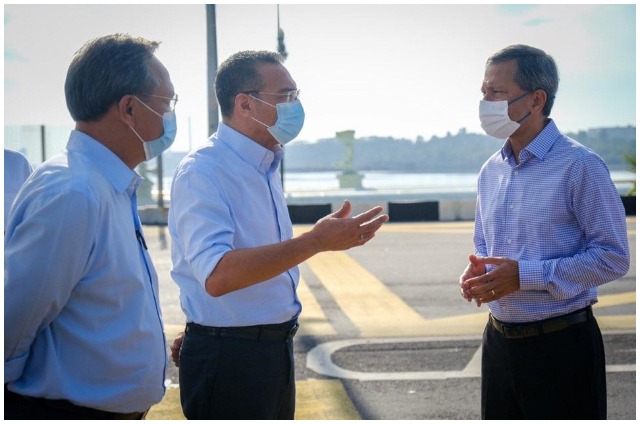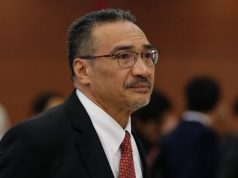Kuala Lumpur, March 18 – Following is the statement by Defence Minister and acting Transport Minister Datuk Seri Hishammuddin Tun Hussein at a press briefing on the search for the missing Malaysia Airlines (MAS) Flight MH370, in Sepang, Selangor, Tuesday:
Introductory Statement
Yesterday, I stated that the search for MH370 had entered a new phase, which brings new diplomatic, technical and logistical challenges.
Today, I would like to give you an update on the logistical and diplomatic aspects of the search.
The search and rescue operations have taken on a new international dimension. The search is still coordinated by Malaysia, but our partners have taken an increasing role in organising and carrying out operations, both within their own territory and also within agreed search sectors. My colleague, the Foreign Minister, Datuk Seri Anifah Aman, will give a more detailed statement on our diplomatic efforts in a moment.
On the logistical front, over the past 24 hours we have been working hard with other countries to narrow the search corridors. Our focus is on four tasks: gathering information from satellite surveillance, analysis of surveillance radar data, increasing air and surface assets, and increasing the number of technical and subject matter experts.
On satellite surveillance, I cannot disclose who has what satellite capability, but I can confirm we have contacted every relevant country that has access to satellite data.
On analysis of radar data, in the southern corridor Australia and Indonesia have agreed to take the lead of their respective parts of the search corridor.
In the northern corridor, China and Kazakhstan have agreed to lead in the search areas closest to their countries.
On air and surface assets, I have spoken to almost all Asean leaders to request further support, including assets with deep ocean surveillance detection capabilities. We are also asking international partners who have assisted us before to take another look at their primary radar data.
1. Operational Update
In the northern corridor, we have divided the search area into seven quadrants. Each of the seven quadrants is 400 nautical miles by 400 nautical miles or 160,000 square nautical miles in total.
We have also divided up the southern corridor into seven quadrants. Just like in the north, each quadrant covers an area of 160,000 square nautical miles.
The entire search area is now 2.24 million square nautical miles.
This is an enormous search area. And it is something that Malaysia cannot possibly search on its own. I am therefore very pleased that so many countries have come forward to offer assistance and support to the search and rescue operation.
In terms of the deployment of specific assets:
Today, the Royal Malaysian Navy deployed two more ships to the southern corridor. This deployment includes a Super Lynx helicopter, which can operate from either ship. This brings the total number of Malaysian ships deployed to the southern corridor to four, with two Super Lynx helicopters.
Today, Malaysia also deployed two C-130 aircraft to the Indonesian sector of the southern search corridor.
Other countries are also contributing the following assets:
The United States has deployed one P-8 Poseidon, and will redeploy a P-3 Orion aircraft.
Australia, as I mentioned yesterday, has deployed three P-3 Orion and one C-130 Hercules.
In terms of the deployment of specific assets:
Today, the Royal Malaysian Navy deployed two more ships to the southern corridor. This deployment includes a Super Lynx helicopter, which can operate from either ship. This brings the total number of Malaysian ships deployed to the southern corridor to four, with two Super Lynx helicopters.
Today, Malaysia also deployed two C-130 aircraft to the Indonesian sector of the southern search corridor.
Other countries are also contributing the following assets:
The United States has deployed one P-8 Poseidon, and will redeploy a P-3 Orion aircraft.
Australia, as I mentioned yesterday, has deployed three P-3 Orion and one C-130 Hercules.
New Zealand is redeploying a P-3 Orion to support Australian search efforts.
The Republic of Korea has committed one P-3 Orion and one C-130 Hercules.
Japan has committed two P-3 Orion, two C-130 and one Gulfstream jet.
The UAE has committed one C-17 aircraft and one Bombardier Dash-8 aircraft.
The assets from Korea, Japan, and the UAE are currently in Malaysia awaiting orders from their respective governments.
Aside from deploying its assets to the northern corridor, China has also made arrangements with Australia to deploy an aircraft to the southern corridor.
2. ACARS (Aircraft Communications Addressing and Reporting System)
I would like to clarify what has been said about ACARS and the sequence of events before the air turn-back.
On Saturday, we stated that
and I quote: Based on new satellite information, we can say with a high degree of certainty that the Aircraft Communications Addressing and Reporting System (ACARS) was disabled just before the aircraft reached the east coast of peninsular Malaysia.
“Shortly afterwards, near the border between Malaysian and Vietnamese air traffic control, the aircraft s transponder was switched off.
These findings were drafted together with representatives from the lead international investigators, based on the information available at the time.
Yesterday, Malaysia Airlines clarified that we cannot determine exactly when ACARS had been disabled, only that it occurred within a specific time range: from 01:07
approximately when the aircraft reached the east coast of peninsular Malaysia, and the last ACARS transmission occurred
to 01:37, which was the next scheduled reporting time. That is indeed the case.
This does not change our belief, as stated, that up until the point at which it left military primary radar coverage, the aircraft s movements were consistent with deliberate action by someone on the plane. That remains the position of the investigating team.
It is also important to recognise that the precise time ACARS was disabled has no bearing on the search and rescue operation. We know that the last known position of the plane as confirmed by the international investigations team was in either the northern or southern corridors, which is where our search and rescue efforts are focused. Our priority has always been to find the aircraft.
3. Police Investigation
I am aware there is a lot of interest in the Royal Malaysia Police investigation into the passengers and crew of MH370. I hope you understand that I cannot comment on the specifics of the investigation, which is still ongoing.
I would also like to state that the search for MH370 is bigger than politics. I urge all Malaysians to put our differences aside and unite during this difficult time as we focus on finding the aircraft and the 239 people on board. 4. Concluding Remarks
The search for MH370 remains our top priority. We will continue to provide you with operational updates, including further information about assets being deployed, as soon as they are available.
In the last few days we have been intensively contacting our friends across the search regions. The cooperation we saw in the first phase continues in this new phase. In fact, there is even more commitment to assist us in this much larger and more complex multinational operation.
In the meantime, our thoughts remain with the families and friends of those on board.
– Bernama











